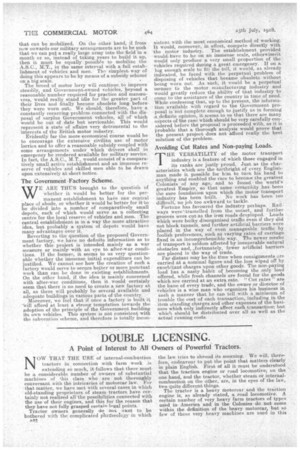DOUBLE LICENSING.
Page 2

Page 3

If you've noticed an error in this article please click here to report it so we can fix it.
A Point of Interest to All Owners of Powerful Tractors.
NOW THAT THE USE of internal-combustion tractors in connection with farm work is extending so much, it. follows that there must he a considerable n.urnber of owners of substantial machines of this class who are not thoroughly conversant with the intricacies of motorcar law. For "that matter, we have met with several cases in which old-standing proprietors of steamtractors, have certainly not realized all'the possibilities connected with the use of their engines, and this for the reason that they have not fully grasped certairtlegat points.
Tractor owners generally do nos want to be bothered with the complicated pirneolegy in which een . the law tries to shroud its meaning. We will, therefore, endeavour to put the point that. matters clearly in plain English. First of all it must be understood that the traction engine or road locomotive, on the one hand, and the tractor, whether steam or internalcombustion on the Other, are, in the eyes of the law, two quite different things. The tractor is a heavy Motorcar and the traction engine is, as already stated, a road locomotive. A certain number of very heavy farm tractors of types used in America and in the Colonies do not come within the definition of the heavy motorcar, but so few of these very heavy machines are used in this country that it is safe to generalize and. to assume that all our tractors come within the definition which prescribes that a heavy motorcar shall not weigh more thaì five tons unladen.
If a heavy motorcar takes the form of a tractor it hauls the whole of its load upon the trailer instead of carrying the whole or part of it upon its own body.
In practice a steam tractor can haul about six tons' of useful load on the trailer; but it may only draw one trailer. This is one of the .points in which it differs. from a road locomotive, -Which may draw two or more trailers.
One might suppose, therefore, that it would he better to have a machine licensed as a road locomotive than as a heavy motorcar, hut here another point of law comes in. The heaviest type of motorcar may travel at five miles an hour -but .a road locomotive. may not travel anywhere at more than four miles an hour, and in many districts its speed is reduced by local regulations to two. miles an hour. The road locomotive is only licensed to run in certain districts, and if it. is desired to use it in another district a fresh licence has to be taken out. "A heavy motorcar licence, on the other hand, permits the engine to run in any part.of. the Country.
Now let us take an irnaginary instance to show to what conclusions all these facts lead. Suppose that the owner of a tractor, licensed as a heavy motorcar, wishes his engine to draw heavy loads, distributed over two or throe trailers, along sonic particular stretch of road where the gradients a.re not so severe as to make the tractor incapable ol. doing the work. If this were the Only work to be done, the machine' would be regiStered as a road locomotive and riot as a motorcar at all, but we assume that on other occasions it is necessary to take -fairly long journeys into
adjacent counties and to cover substantial mileage in the course of a day. For this latter purpose itis a distinct advantage -to have the engine licensed as a motorcar.
. _Now, when these, two classes of work are combined and alternate with one another, it would evicleyoy be a good plan if the engine could be a motorcar one day and a road: locomotive tho next.. This is just the effect that can be produced by the process known as
double licensing. That is to say, by paying the necessary fees to licence the engine both for general use as a motorcar and also for use hi a particular districtas a road locomotive. If this is done, we can take our choice as to the capacity in winch we use the engine on any particular jotirney. We can run it with one trailer at five miles. an hour or, if coiatente.f.t -with a lower speed, we can hitch on one or two additional trailersand deal with big loads somewhat iore slowly. • Some local authorities rather resent this process Of double licensing,. having an idea that it is intended as a means of evading the law. There may have been a few instances in Which this view has been justified, but in general it is; a perfectly legitimate proceeding and may be very useful indeetl.to the owner of the engine without giving any grounds Whatever' for complaint by those. responsible for the maintenance either of the law or. of the local roads.
• It is possible that When the war is over the law may be: modified so that the general argument ,contained in this note will Cease to be valid, but for the present' it is all perfectly sound. and presents a means not Sufficiently known to quite a large . percentage of tractor owners, by which the utility of an engine may he materially increased. To-day, •particularly, must the fullest use be Made of every engine:






















